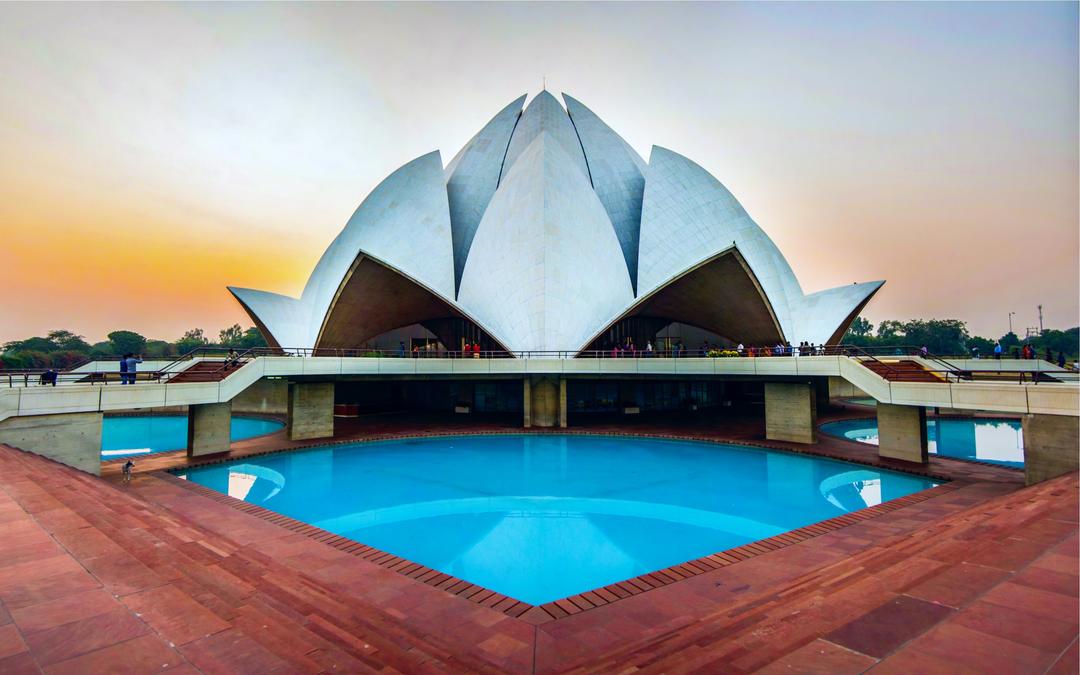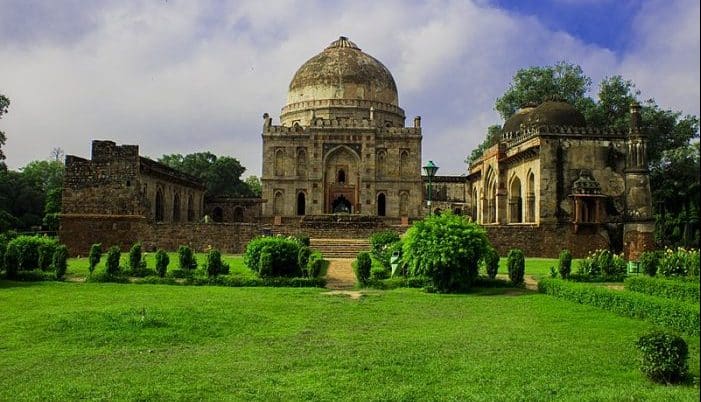Delhi, the capital city of India, is not just a destination; it is an experience. Rich in history, culture, diversity, and modern energy, Delhi has something for every traveler.
From Mughal forts and ancient tombs to bustling markets and spiritual sanctuaries, the city is a living museum.
Whether you are a history enthusiast, a foodie, a spiritual seeker, or someone just looking to explore something new, Delhi promises to surprise and inspire you at every turn
This guide to the top 10 Places in Delhi is designed to help you uncover the true essence of the city — one destination at a time.
1. Explore the Red Fort – A Journey into Mughal Majesty

The Red Fort, also known as Lal Qila, is one of the most iconic monuments in India and a UNESCO World Heritage Site. Built in 1638 by the Mughal emperor Shah Jahan, the fort is a stunning example of Indo-Islamic, Persian, and Timurid architecture. Its massive red sandstone walls stretch over two kilometers and once housed emperors, ministers, and military officers.
Inside the fort, visitors can walk through majestic halls such as the Diwan-i-Aam, where emperors addressed the public, and the Diwan-i-Khas, which was reserved for private audiences. The intricate marble designs, floral motifs, and inlay work showcase the brilliance of Mughal craftsmanship. The fort also includes the beautiful Moti Masjid, or Pearl Mosque, and the royal hammam, or bath.
A visit to the Red Fort is not just a historical tour; it is an opportunity to step back in time and imagine the grandeur of the Mughal era.
Also Read: The Ultimate Festival Travel Guide: Celebrate Culture Around the World
2. Visit Jama Masjid – The Spiritual Heart of Old Delhi

Located just a short walk from the Red Fort, Jama Masjid is one of the largest and most revered mosques in India. Built by Shah Jahan in 1656, the mosque is a masterpiece of Mughal architecture, made of red sandstone and white marble. It can accommodate over 25,000 worshippers in its vast courtyard.
The mosque features three large domes, two minarets standing at over 40 meters, and a broad flight of stairs leading up from three grand gateways. The interior is adorned with beautiful calligraphy, symmetrical arches, and detailed carvings. Visitors can climb the southern minaret to enjoy panoramic views of Old Delhi and the surrounding bazaars.
Jama Masjid remains an active place of worship and is a deeply spiritual site that reflects India’s religious diversity and cultural unity.
Also Read: The Ultimate Festival Travel Guide: Celebrate Culture Around the World
3. Get Lost in the Bustling Streets of Chandni Chowk
One of the oldest and busiest markets in Delhi, Chandni Chowk is a sensory overload of sights, sounds, and smells. Established in the 17th century by Shah Jahan’s daughter, Jahanara Begum, the market was designed to be the commercial hub of Mughal Delhi. Today, it remains a thriving marketplace that offers everything from spices and textiles to jewelry and electronics.
The real magic of Chandni Chowk lies in its street food. From crispy parathas at Paranthe Wali Gali to creamy kulfi and spicy chaat, this area is a haven for food lovers. You can also explore the famous Khari Baoli, Asia’s largest spice market, and Dariba Kalan, known for its traditional jewelry.
Navigating the narrow lanes on foot or by cycle rickshaw is the best way to soak in the old-world charm of this historic neighborhood.
Also Read: The Ultimate Festival Travel Guide: Celebrate Culture Around the World
4. Admire the Grandeur of Qutub Minar

Located in South Delhi, Qutub Minar is a soaring 72.5-meter tall minaret built in 1193 by Qutb-ud-din Aibak, the founder of the Delhi Sultanate. It is made of red sandstone and marble and features five distinct storeys, each marked by a projecting balcony and intricate carvings.
The surrounding Qutub Complex includes several other important historical monuments, such as the Quwwat-ul-Islam Mosque, the first mosque built in India, and the Iron Pillar, which has stood rust-free for over 1,600 years. The architecture reflects the early Indo-Islamic style and is considered a masterpiece of design and engineering.
A visit to Qutub Minar offers not only a look at the architectural brilliance of medieval India but also a peaceful escape in the form of the lush gardens that surround the complex.
Also Read: The Ultimate Festival Travel Guide: Celebrate Culture Around the World
5. Experience Peace at the Lotus Temple

One of the most architecturally stunning landmarks in Delhi, the Lotus Temple is a Baháʼí House of Worship open to people of all religions. Completed in 1986, the temple is shaped like a blooming lotus flower with 27 white marble petals arranged in clusters to form nine sides.
Unlike most temples, there are no idols, pictures, or religious symbols inside. Instead, the atmosphere is one of calm and introspection. Visitors are encouraged to sit silently and meditate, regardless of their faith or beliefs.
The surrounding gardens, reflective pools, and lush green lawns add to the serenity of the experience. The Lotus Temple is not only a place of worship but also a symbol of peace, unity, and spiritual oneness.
Also Read: The Ultimate Festival Travel Guide: Celebrate Culture Around the World
6. Step into Mughal History at Humayun’s Tomb

Humayun’s Tomb is another UNESCO World Heritage Site and a precursor to the Taj Mahal in Agra. Built in 1570 by Humayun’s widow, Empress Bega Begum, it was the first garden-tomb on the Indian subcontinent.
The structure is a fine example of Mughal architecture, combining Persian design elements with local craftsmanship. The tomb is set in the middle of a charbagh, a Persian-style four-part garden, divided by water channels and walkways.
As you walk through the serene gardens and admire the red sandstone and white marble dome, you’ll gain a deeper appreciation for the artistic and cultural legacy of the Mughal Empire.
Also Read: The Ultimate Festival Travel Guide: Celebrate Culture Around the World
7. Relax and Rejuvenate in Lodhi Garden

For those looking to escape the hustle and bustle of the city, Lodhi Garden is a perfect retreat. Spread over 90 acres, the park is home to tombs and monuments from the Lodi and Sayyid dynasties dating back to the 15th century.
You’ll find historical structures like the tomb of Sikandar Lodi, the Bara Gumbad, and the Shisha Gumbad, all nestled among lush gardens, flowering trees, and shaded pathways. It’s a favorite spot for morning walks, yoga sessions, and weekend picnics.
Lodhi Garden is a peaceful oasis in the middle of a chaotic city and offers a unique blend of history, nature, and relaxation.
Also Read: The Ultimate Festival Travel Guide: Celebrate Culture Around the World
8. Explore India’s Past at the National Museum

Located on Janpath, the National Museum in Delhi is one of the largest museums in India. It houses over 200,000 artifacts covering more than 5,000 years of Indian history, from the Indus Valley Civilization to the modern era.
Highlights include sculptures, coins, paintings, manuscripts, arms and armor, textiles, and archaeological finds. One of the most fascinating sections is the Harappan Gallery, which showcases the sophistication of one of the world’s earliest urban civilizations.
A visit here is essential for anyone interested in Indian history, art, and culture. The museum is both educational and engaging, perfect for adults and children alike.
Also Read: The Ultimate Festival Travel Guide: Celebrate Culture Around the World
9. Marvel at the Modern Beauty of Akshardham Temple

Opened in 2005, Akshardham Temple is a spectacular modern temple that showcases the cultural and spiritual heritage of India. Built using traditional methods and materials, the temple features intricately carved stone pillars, statues, and domes.
The temple complex also includes a large stepwell, musical fountain, and exhibitions that tell the story of Indian civilization and spiritual values. The boat ride inside the complex is particularly popular, as it takes visitors on a journey through 10,000 years of Indian history.
Though photography is not allowed inside, the sheer grandeur and detail of the temple architecture will remain etched in your memory.
Also Read: The Ultimate Festival Travel Guide: Celebrate Culture Around the World
10. Learn About the Stars at Nehru Planetarium

If you’re traveling with children or are fascinated by space and astronomy, the Nehru Planetarium is a great place to visit. Located in the Teen Murti Bhavan, the former residence of Jawaharlal Nehru, the planetarium features interactive exhibits, space models, and frequent astronomy shows.
The Sky Theatre presents fascinating visual displays of planets, stars, galaxies, and astronomical phenomena. Workshops and programs are also organized for school groups and amateur astronomers.
The planetarium is both fun and educational, offering a refreshing and intellectual break from the historical sites.
Also Read: The Ultimate Festival Travel Guide: Celebrate Culture Around the World
Conclusion: Delhi – A City of Endless Discoveries
Exploring Delhi is like reading a book filled with stories from different eras, cultures, and communities. From the grandeur of the Mughal Empire to the vibrant chaos of street markets, every corner has a tale to tell. Whether it’s your first time in the city or you’re returning for another visit, these top 10 Places in Delhi will help you connect deeply with the spirit of India’s capital.
Make sure to plan your days wisely, wear comfortable shoes, and most importantly, keep your curiosity alive — because in Delhi, adventure is always just around the crone
Also Read: The Ultimate Festival Travel Guide: Celebrate Culture Around the World

